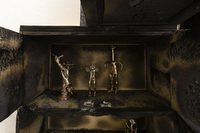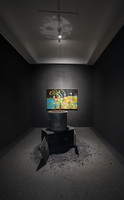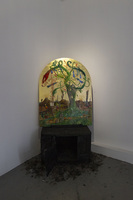In 1369 the Bishop of Cracow imposed an interdict and a curse on Bytom. The reason for the anathema was a verdict of the municipality by which two local priests were executed. Local history became Tomasz Kulka's artistic inspiration.
The more archaic the structures on which a community is based, the more the zone of the sacred increases in scope and the more stringent the prohibitions become. The Middle Ages had a number of tools for exclusion from society, either temporarily or permanently. The main source of prejudice was the hostile stance of the church, which led to intolerance, and finally to social aggression. Sin was considered the greatest threat to the community, and persistence in it was punished by exclusion, of which excommunication was the most commonly practised tool. This form of exclusion formed one of the most important structures of religious and social consciousness. It represented the most severe punishment, breaking the bond not only between the believer and the church, but also society as a whole. From the turn of the fourth and fifth centuries, synods and councils tightened its scope, increasingly banning the faithful completely from contact with the excommunicated person. Excommunication was also threatened for association with the excluded. It was a powerful weapon also due to the fact that there were strong implications in the profane sphere. Ecclesiastical authority began to spill over more and more into secular life over time, the curse often amounting to banishment. In 1184, for example, Pope Lucius III and Emperor Frederick aligned themselves against Italian heretics, who were to be deprived of all rights, property and estates by means of excommunication. Accursed persons were not admitted to public offices and councils and had no testamentary capacity. Condemned lawyers or officials lost the right to practise their profession and their judgements were cancelled.
In 1369 the Bishop of Cracow imposed an interdict and a curse on Bytom, which was upheld by Pope Urban V. The reason for the anathema was a verdict of the community by which two local priests were executed. From texts by Jan Długosz and Nicolas Liebental, we learn that the immediate cause of the verdict was an insulting sermon indirectly addressed to the town authorities. In a short hearing, the townspeople found both priests guilty and sentenced them to death by drowning in a pond. The priests were not even helped by a monstrance to guarantee their immunity. The sentence was carried out in a rather drastic manner, for when the bodies refused to drown, the Bytomians used axes to split the condemned men's heads open. The consequences of this act for the city were disastrous. No religious services were held in the town for two years, merchants shunned the town, and as a result Bytom lost, among other things, its trading partners.
Local history became Tomasz Kulka's artistic inspiration. The resulting exhibition of paintings, complemented by stage design elements, installations and objects - creating a world of imaginary religion - refers in its form to the spirit of the Middle Ages, the categories of curse and exclusion, punishment and reward, faith used as a tool for manipulation. It is also a continuation of the artist's earlier work, inspired by ancient art, with a universal character, creating an overall impression of a space both sacred, magical, divine and disturbing, devilish, set on the border between sacrum and profanum.
TOMASZ KULKA (born 1979 in Olkusz) - graduate of the Academy of Fine Arts in Krakow, diploma with honours in the painting studio of Prof. Grzegorz Bednarski and in the ceramic studio of Prof. Czesław Dźwigaj. Doctorate at the Faculty of Painting of his alma mater (2019). Scholarship holder of the National Cultural Centre - Young Poland programme (2013), Ministry of Culture and National Heritage (2012, 2022) and the Artistic Scholarship of the Mayor of Wrocław (2022). Two-time winner of the Bielska Jesień Painting Biennale. A native of Wolbrom, he lives and works in Wrocław.
- Exhibition
- 23 November 2024 ‒ 24 January 2025
- opening: 23.11. (Saturday) from 7:00 pm to 9:30 pm
- artist: Tomasz Kulka
- curator: Agata Cukierska
- media partner: Notes na 6 Tygodni
- tickets: 1 PLN (for school groups), 3 PLN (reduced), 6 PLN (regular)






















